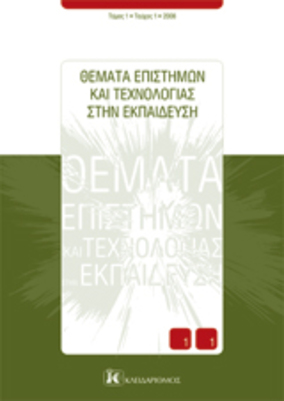Ανάπτυξη και αξιολόγηση διδακτικού υλικού για προώθηση της κατανόησης μαθητών λυκείου για το μηχανισμό λειτουργίας του φαινομένου του θερμοκηπίου
Part of : Θέματα επιστημών και τεχνολογίας στην εκπαίδευση ; Vol.5, No.1-2, 2012, pages 127-139
Issue:
Pages:
127-139
Author:
Abstract:
Η παρούσα εργασία αναφέρεται στην προσπάθεια ανάπτυξης και ερευνητικής επικύρωσης διδακτικού υλικού για την προώθηση κατανόησης μαθητών λυκείου για το μηχανισμό λειτουργίας του φαινόμενου του θερμοκηπίου. Το διδακτικό υλικό είναι μέρος ενός ευρύτερου μαθησιακού περιβάλλοντος στη διαδικτυακή πλατφόρμα ΣΤΟΧΑΣΜΟΣ, ενώ περιλαμβάνει επιπρόσθετα πειραματικές δραστηριότητες και αντίστοιχα φύλλα εργασίας. Το διδακτικό υλικό επιχειρεί να καθοδηγήσει τους μαθητές να αναπτύξουν αρχικά επιμέρους ιδέες στις οποίες στηρίζεται το φαινόμενο και να τις συνθέσουν σταδιακά, ώστε να οικοδομήσουν το μηχανισμό λειτουργίας του. Το διδακτικό υλικό έχει εφαρμοσθεί σε συνεργασία με μια ομάδα 25 μαθητών λυκείου. Έχουν συλλεχθεί δεδομένα πριν και μετά την εφαρμογή του, μέσω γραπτών έργων αξιολόγησης και συνεντεύξεων, ώστε να διερευνηθεί η εξέλιξη στην κατανόηση των μαθητών. Τα αποτελέσματα της επεξεργασίας των δεδομένων φανερώνουν τη δυνατότητα της διδακτικής ακολουθίας να προωθεί αποτελεσματικά την εννοιολογική κατανόηση των μαθητών. Ειδικότερα, καταδεικνύουν τη σημαντική βελτίωση στην ικανότητά τους να περιγράφουν το μηχανισμό λειτουργίας του φαινόμενου και να τον εφαρμόζουν σε ανοίκειες καταστάσεις για να διατυπώσουν προβλέψεις για τη θερμοκρασία της γης.
Subject:
Subject (LC):
Notes:
Περιέχει πίνακες και βιβλιογραφία, Το άρθρο περιέχεται στο ειδικό αφιέρωμα: "Αλληλεπιδράσεις εκπαιδευτικής έρευνας και πράξης στις Φυσικές Επιστήμες"
References (1):
- Ahn, W., & Kalish, C. W. (2000). The role of mechanism beliefs in causal reasoning. In F. C. Keil & R. A.Wilson(eds.), Explanation and Cognition (pp. 199-226). Cambridge, MA: MIT Press.Andersson, B., & Wallin, A. (2000). Students’ understanding of the Greenhouse Effect: Societal Consequences ofreducing CO2 emissions and why ozone layer depletion is a problem. Journal of Research in Science Teaching,37(10), 1096-1111.Boyes, E., & Stanisstreet, M. (1993). The “Greenhouse Effect”: Children’s perceptions of causes, consequences andcures. International Journal of Science Education, 15, 531–552.Boyes, E., & Stanisstreet, M. (1997). Children’s models of understanding of two major global environmentalissues (ozone layer and greenhouse effect). Research in Science and Technological Education, 15(1), 19–28.Boyes, E., & Stanisstreet, M. (2001). Plus ça change, plus c‟est la même chose? School students’ ideas about the“greenhouse effect” a decade on. Canadian Journal of Environmental Education, 6, 77-101.Glennan, S.S. (1996). Mechanisms and the nature of causation. Erktenntnis, 44, 49-71.Hansen, P. J. K. (2009). Knowledge about the Greenhouse Effect and the effects of the ozone layer amongNorwegian pupils finishing compulsory education in 1989, 1993, and 2005 what now?. International Journal ofScience Education, 32(3), 397-419.Kaartinen, S., & Kumpulainen, K. (2002). Collaborative inquiry and the construction of explanations in thelearning of science. Learning and Instruction, 12, 189-212.Kesidou, S., & Roseman, J. L. (2002). How well do middle school science programs measure up? Findings fromProject 2061’s curriculum review. Journal of Research in Science Teaching, 39, 522–549.Koslowski, B. (1996). Theory and evidence: The development of scientific reasoning. Cambridge, MA: MIT Press.Koulaidis, V., & Christidou, V. (1999). Models of students’ thinking concerning the greenhouse effect andteaching implications. Science Education, 83(5), 559–576.Liarakou, G., Athanasiadis, I., & Gavrilakis, C. (2010) What Greek secondary school students believe aboutclimate change?. International Journal of Environmental and Science Education 6(1), 79-98.Machamer, P., Darden, D., & Craver, C. (2000). Thinking about mechanisms. Philosophy of Science, 67, 1-25.McDermott, L. (1991). Millikan Lecture 1990: What we teach and what is learned-Closing the gap. AmericanJournal of Physics, 59, 301-315.McDermott, L. and the Physics Education Group at the University of Washington (1996). Physics by Inquiry. NewYork, USA: Wiley.Meira, P. A. (2006). People’s ideas about climate change. Ciclos, 18, 5–12NRC (2007). Taking science to school: Learning and teaching science in grades K-8. Washington, DC: NationalAcademy Press.Österlind, K. (2005). Concept formation in environmental education: 14-year olds' work on the intensifiedgreenhouse effect and the depletion of the ozone layer. International Journal of Science Education, 27(8), 891- 908.Punter, P., Ochando-Pardo, M., & Garcia, J. (2010). Spanish secondary school students' notions on the causes andconsequences of climate change. International Journal of Science Education, 33 (3), 447-464.Russ, R. S., Scherr, R. E., Hammer, D., & Mikeska, J. (2008). Recognizing mechanistic reasoning in studentscientific inquiry: A framework for discourse analysis developed from philosophy of science. ScienceEducation, 92(3), 499- 525.Shepardson, D. P., Niyogi, D., Choi, S., & Charusombat, U. (2011). Students' conceptions about the greenhouseeffect, global warming, and climate change. Climatic Change, 104 (3-4), 481-507.Weber, R. P. (1990). Basic content analysis. Newbury Park, CA: Sage Publications (2nd ed.).




